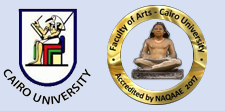عنوان المقال عربي
التجسيد الفني للحرية في شعر محمود درويش ّ
Document Type
Book Review
كلمات مفتاحية عربي
محمود درويش, الشعراء الفلسطينيين, شعراء العرب
Abstract English
There is an inseparable link between poetry and freedom which extends back to the relationship between poetry and the history of humanity. In its essence, poetry represents a sublime representation of the conflict between the need to establish limits and restrictions and to organize life, which is a necessity of survival and urbanization, and the need for partial or total escape from these limits. Mahmoud Darwish (1941-2008) is one of the leading Arab and Palestinian poets whose poetry tackled the issue of freedom extensively who was concerned with the crisis of his homeland during his stay in Palestine and his exile. His poems assert his poetic mastery that transcends the dilemma of the status quo without ignoring current Arab and Palestinian impasse, transforming the tragedy into an epic of resistance overcoming despair. The paper is divided into an introduction and five sections. The first is entitled “Missing Freedom and the Lost Homeland”. The second section tackles “Time and the Poetic Structure of Freedom Poems”, whereas the third deals with “Place and the Poetic Structure of Freedom Poems”. After that, the paper discusses “The Embodiment of Freedom and the Symbolism of Colours”. The final section deals with “The Poetic Language of Freedom” and this is followed by the conclusion and the list of references.
الملخص العربي
العلاقة بين الشعر والحرية علاقة أزليّة، تكاد تمتد امتداد العلاقة بين الشعر وتاريخ البشرية؛ ذلك لأنها تمثل تجسيدًا راقيًا لقضية الصراع بين الحاجة إلى القيود المُنظمة للحياة وهي إحدى ضرورات تنظيم التمدن والبقاء، والحاجة إلى الفكاك الجزئي أو الكلي من هذه القيود. ومحمود درويش (1941 – 2008) أحد أهمّ الشعراء الفلسطينيين وشعراء العرب الذين ارتبط اسمهم بشعر الحرية، واكب درويش من الوطن والمنفى قضية الشعب الفلسطيني، من مواقع النضال، ومواقع الريادة الشعرية، وكشف عن شاعرية تسمو عن رعب الواقع دون أن تتجاهله أو تتجاهل فلسطين وأهلها والعرب وتاريخهم وحاضرهم. وجاء البحث في مقدمة، وخمسة محاور بدأت الحديث عن الحرية المفقودة والوطن الضائع، ثم انتقلت إلى الزمان والبناء الفني في قصائد الحرية، ثم أوضحت أهمية المكان والبناء الفني في قصائد الحرية، وتحدثت بعدها عن تجسيد صورة الحرية ودلالة اللون، وفي المحور الأخيرة تحدثت عن تشكيل اللغة الشعرية للحرية ثم أنهيت البحث بالخاتمة والهوامش التي تحتوي على مراجع البحث.
Recommended Citation
Abdul Latif, Abdel Tawab Mahmoud Abdel Tawab
(2018)
"The Poetic embodiment of freedom in Mahmoud’s Darwish’s Poetry,"
Journal of the Faculty of Arts (JFA): Vol. 78:
Iss.
4, Article 13.
DOI: 10.21608/jarts.2018.83541
Available at:
https://jfa.cu.edu.eg/journal/vol78/iss4/13
Digital Object Identifier (DOI)
10.21608/jarts.2018.83541
Accept Date
2017-04-18
Publication Date
10-1-2018

